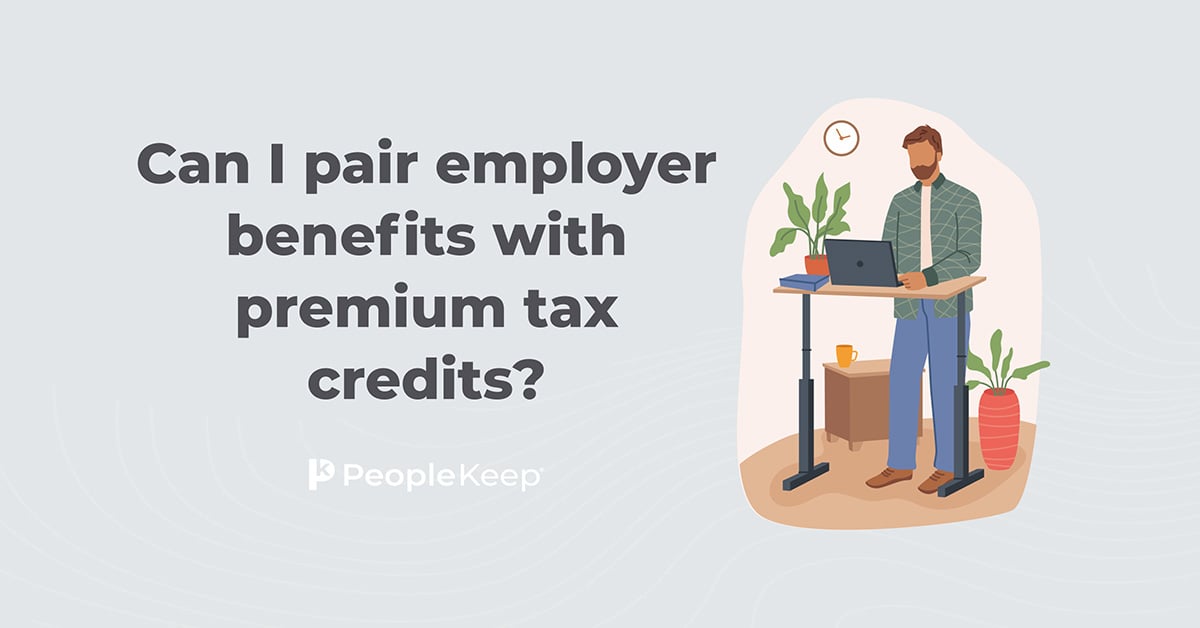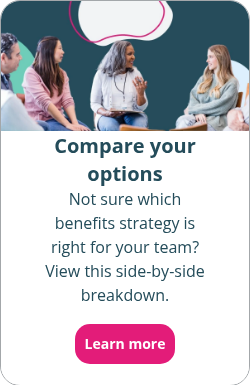What to do if high claims are driving up your group health insurance costs
By Elizabeth Walker on July 2, 2025 at 8:00 AM
Rising group health plan costs can be a significant challenge for employers when employee medical claims start straining the budget. If your company is facing steep renewal rates or unpredictable expenses because of costly claims, you're not alone. Many employers are looking for better ways to manage risk, control healthcare spending, and still provide competitive benefits that attract and retain talented workers.
In this article, we’ll explain how high claims impact group health premiums and discuss alternative solutions that can help you keep costs down without losing quality coverage.
In this blog post, you’ll learn:
- Why high medical claims cause group health plan premiums to rise, and how insurers calculate rates based on your staff’s risk and claim history.
- Which types of health plan coverage are most affected by high medical claims.
- Cost-saving alternatives to self-funded and fully-insured group health plans that can help you offer robust employee benefits while keeping your budget in check.
Why do high medical claims raise fully-insured group health insurance costs?
High medical claims raise large group health plan costs because insurers calculate premiums based on the enrolled employees’ risk and claims history.
Past claims are just one factor insurance carriers use to determine your rates. But they play a big role. This is because costly medical claims make a “group” of employees more expensive to insure. The greater the risk of coverage, the higher the premiums for you and your staff.
Below are more detailed reasons why this happens:
- When employees enrolled in a group health plan frequently seek costly medical services — such as inpatient hospital stays, surgeries, or treatment for a chronic condition — the insurance company must pay more money to cover the claims. They offset these higher claims by raising your premium costs.
- Insurers often raise premium rates for groups that submit many or more expensive health claims on average. This helps insurance companies manage risk, stay profitable, and have enough money from premiums to cover future claims and administrative costs.
- Typically, employers and employees enrolled in a group plan share the cost of premiums. Even if only a few employees in the group submit high medical claims, the average cost per person increases. This can lead to higher renewal rates for the entire group.
- In many states, if you have more than 50 employees in your group plan, insurers will use an “experience rating” to calculate your premium. This method compares your group's past claims history to expected claims for similar groups within the same industry. If an insurer determines your group’s claims history is higher than that of other groups, you can expect higher premiums in the future.
Keep in mind that this only applies to non-SHOP group plans.
Which types of health plans are affected by high medical claims?
Under the Affordable Care Act (ACA), insurance carriers can’t consider your company’s medical claims history when issuing a small group health plan or ACA-compliant individual health coverage. While there are other factors insurance carriers use to determine the premium rates of these plans, your employees’ claims aren’t one of them.
However, high health claims can impact premium rates for two types of group health plans. We’ll walk you through them in the sections below.
Non-SHOP fully-insured group health plans
Non-SHOP fully-insured group health insurance is the first type of coverage that can experience higher rates due to costly medical claims. Fully-insured traditional group health coverage is a type of policy that employers choose and offer to a group of employees and their eligible family members. Businesses with 51 or more employees are typically a “large group.” However, smaller groups can also get non-SHOP coverage directly from a carrier.
These plans can sometimes be more affordable for employees because the insurer spreads risk across all participating members. But the downside is that insurance providers can determine non-SHOP group health plan premiums using your group’s overall health and claims history.
For example, suppose your workforce has older individuals with chronic conditions or gains new employees who frequently file costly claims. In these cases, the premiums for the entire group may increase at renewal time.
Self-funded health plans
The next type of health plan affected by high medical claims is self-funded health plans. With this type of coverage, employers take on the responsibility of covering employee medical claims and any administrative fees directly rather than paying fixed premiums to an insurer.
Companies that self-fund have greater flexibility in plan design and cost control. But they also assume more financial risk. Claim costs can vary significantly from one month to the next, and a few major claims can blow your budget.
Many employers buy optional stop-loss insurance to protect against unexpectedly high claim payments. But stop-loss protection comes with its own monthly premium. Plus, if your claims frequently exceed the predetermined limit, your stop-loss rates can rise the following year. Or, the stop-loss policy could laser your high-claim employees, meaning they won’t cover the excess.
Alternatives to group health insurance that can keep your healthcare costs low
If rising group health insurance costs and your employees' medical claims are straining your budget, there are other ways to provide health coverage to your employees. We’ll go over two options available to you in the sections below: level-funded health plans and health reimbursement arrangements (HRAs).
Level-funded insurance plans
A level-funded health plan blends aspects of fully-insured and self-funded insurance policies. With this type of coverage, the employer pays an insurance company a fixed or “level” monthly amount of money. In turn, the insurer covers employees’ medical claims, stop-loss insurance, and administrative costs on the employer’s behalf.
Here’s how it works:
- Employers contribute to a claims fund, which the insurer uses to pay for eligible employee medical expenses throughout the plan year.
- Policies typically have a maximum claims limit per employee, ranging from $10,000 to $100,000, depending on the employer's risk tolerance and budget.
- If an employee’s medical costs exceed the amount in the claims fund, stop-loss insurance covers the additional expenses. Unlike self-funded insurance, employers must have stop-loss protection with a level-funded plan.
- The rest of the employer’s monthly payment goes toward administrative support for the insurer or a third-party administrator (TPA). The insurance carrier or TPA helps the employer manage the benefit and fulfill regulatory compliance requirements.
Level funding can offer cost predictability and potential savings while still giving employers some control over their healthcare spending. Since you pay a flat monthly rate, planning your benefits budget is easier.
But these plans may not be an option in every state due to regulations on stop-loss insurance. And while they can be cost-effective, if your fund runs low and your employees exceed claim limits, your stop-loss protection premiums may rise when it’s time to renew. You can also only receive unused funds in the claims account if your original claims projections were accurate.
Individual coverage HRA (ICHRA)
Before we discuss the ICHRA, let’s review the basics of how HRAs work. An HRA is an employer-owned health benefit that reimburses employees tax-free for their individual health plan premiums and qualified medical expenses. Eligible out-of-pocket costs include inpatient and outpatient care, doctor visits, prescription drugs, and deductibles.
With an HRA, you set a monthly allowance that employees can use on out-of-pocket healthcare costs and individual insurance policies. After they show proof of a qualified purchase, you reimburse employees up to their allowance amount. Any unused funds remain with you at the end of the plan year or if the employee leaves your company.
Now, let’s get to the ICHRA. This type of flexible benefit is a stand-alone HRA. This means that instead of buying fully-insured group health insurance, you give your staff an allowance and they can choose the individual health plan and other medical expenses that best meet their needs.
Because you don’t buy a fully-insured health plan or work with an insurer, your employees’ medical claims won’t affect your healthcare budget. Your employees’ individual plans handle the risk of coverage. Plus, medical claims don’t influence their premium costs. You also don’t have to buy stop-loss policies with an HRA, which saves you money and hassle.
Here’s a quick breakdown of the ICHRA’s features:
- ICHRAs are available to employers of any size and don’t have minimum or maximum limits on how much you can contribute.
- You can customize eligibility and allowance amounts by employee classes for better personalization and cost savings.
- To participate in the benefit, employees must have qualified individual health insurance coverage.
- Applicable large employers (ALEs) can use an ICHRA to satisfy the ACA’s employer mandate instead of buying expensive group coverage.
- Premium tax credits and ICHRAs can coordinate depending on whether the benefit is affordable. If it’s affordable, employees must waive their credits to opt into the ICHRA. They can opt out and keep receiving their subsidy if it's unaffordable.
Compared to group health insurance, HRAs are more stable and scalable. There are no annual rate hikes or minimum participation limits. Plus, HRA reimbursements are exempt from payroll taxes for employers and are income tax-free for employees.
Qualified small employer HRA (QSHERA)
A QSEHRA is also a stand-alone HRA, but it’s only for small businesses with fewer than 50 full-time equivalent employees (FTEs). While it has a maximum company size limit, you can offer the QSEHRA as long as you have at least one W-2 worker. This makes it an ideal option for small businesses looking to avoid the complexity and cost of self- or level-funded plans.
Like the ICHRA, QSEHRAs pair with individual health insurance. So, you don’t need to buy a group health plan for your staff or worry about the financial impact of large medical claims.
Here’s a quick overview of how the QSEHRA works:
- The federal government sets annual maximum contribution limits for QSEHRAs. But within those caps, you can customize monthly allowances based on age and household size.
- Small businesses must offer the QSEHRA to all their full-time W-2 workers. You can also include part-time employees in the healthcare benefit. But you must give the same allowance as full-time staff members.
- You can design their QSEHRA to reimburse employees for health plan premiums and out-of-pocket costs or limit the benefit to premiums only.
- Employees must have a health plan that provides minimum essential coverage (MEC) to use the QSEHRA.
- Staff members who qualify for premium tax credits can collect their subsidy if their QSEHRA allowance is unaffordable. But, under federal law, they must reduce their credits by their HRA allowance amount.
QSEHRAs provide small businesses with predictable monthly costs and fewer administrative burdens than traditional or self-insured health plans.
Conclusion
High employee medical claims can be unpredictable and costly, but they don’t have to derail your benefits strategy or budget. If you’re offering a large group or self-funded health plan, understanding how claims history impacts your premiums is the first step toward regaining control.
Opting for flexible alternatives like an HRA can help you manage risk and rein in your budget while still providing high-quality, competitive benefits. And with PeopleKeep by Remodel Health, you don’t have to design and manage your HRA alone.
Check out more resources
See these related articles

Pros and cons of the individual coverage HRA
Considering an individual coverage HRA (ICHRA)? Discover the pros and cons of this healthcare option to make an informed decision.

Can I pair employer benefits with premium tax credits?
Discover if you can combine employer benefits with premium tax credits when it comes to health insurance. Get all the answers in this informative post.

What is the family glitch, and is it fixed?
Curious about the Family Glitch and its impact on your healthcare coverage? Find out everything you need to know.




